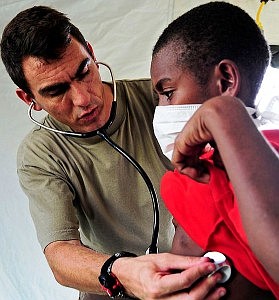Doctor Shortage to Impact Low Income Communities
Underserved communities are expected to see a demand for primary care physicians grow by about 10 percent -- the largest expected increase in 12 local communities examined in a study published last week by Health Affairs journal.
The study finds that expansion of insurance coverage under the Affordable Care Act (ACA), with an expected increase in demand for primary care physicians, would directly impact some 44 million people who live in areas where the projected increase in demand for primary care providers is greater than 5 percent.
Nationwide, at least 7 million Americans live in areas where demand for additional primary care doctors will jump by more than 10 percent, according to Elbert Huang, MD, associate professor of medicine at the University of Chicago Medicine, and co-author Howard Finegold, an analyst in the Department of Health and Human Services' Office of the Assistant Secretary for Planning and Evaluation.
Some of Chicago's poorest and underserved neighborhoods are expected to see the greatest demand for additional primary care doctors in 2014, as the Affordable Care Act boosts the number of newly insured patients seeking medical services, a new study has found.
"You might be able to dramatically reduce the number of people who are uninsured, but it does not ensure there's a provider waiting for you once you get that insurance card," said Huang.
The study, sited in a University of Chicago press release, forecasts that 29 million people will get health insurance for the first time in 2014 under the health care law, resulting in 26 million additional doctor visits per year. That, in turn, will require 7,200 more primary care providers, including doctors, nurse practitioners and physician assistants, at a time when the numbers of these practitioners are falling.
Huang's report found the expected rise in demand for primary care physicians will hit different parts of the country harder than others.
For Chicago, the report notes that areas expected to see the greatest demand for primary care doctors have fewer providers per 100,000 population, lower median incomes and higher proportions of blacks and Hispanics.
"The places that don't have enough primary care physicians now are the places where people are under-insured or uninsured," said Kohar Jones, MD, director of Community Health and Service Learning at Pritzker, in response to the study. "So places that already have shortages of primary care physicians are the places where the changes of the ACA would be most likely to bring more people into the system, driving up demand."
The Affordable Care Act attempts to expand the primary care workforce by incentivizing doctors or future doctors to choose it as a specialty, such as a funding boost to the National Health Service Corps, a federal program that offers financial assistance to support primary care doctors in medically underserved areas.
In addition, the law calls for an increase in the level of Medicaid reimbursements to doctors who practice primary care, which includes family practice, internal medicine and pediatrics.
Historically, physicians have made up for lower reimbursement rates by shortening individual visits and seeing more patients. In the case of primary care doctors, the number of practices that use nurse practitioners and physician assistants to shoulder some of the responsibilities of treating additional patients may increase, Huang noted.
"Beyond that, there's no way we can grow enough doctors in that short of time to accommodate this dramatic increase," he added. "There is a market opportunity to be a primary care service provider; it's just that we need people to realize that and take advantage of it."
By Deborah Bayliss
Latest Stories
- Comcast Launches NOW – a New Brand and Product Portfolio that Redefines Low-Cost Internet, Mobile, and TV
- Wards365 Announces Summer50 Fest on Saturday, May 18 at United Center City-Wide Resource Festival focused on Summer Activities for Youth and Families
- The Magic Of Alvin Ailey Comes To The Auditorium Theater
- BOSS Impact Funds Gives Black Women Entrepreneurs Access To Capital
- Closing the Black Maternal Health Gap Is At The Center Of Organization’s Work
- Praize Productions’ Production Shows That ‘Black Love Reigns Supreme’
- Chicago Public Schools Announces 2024-25 Preschool Application Launch
- State Treasurer Michael Frerichs Pushes to Reunite Residents with Unclaimed Property, Missing Money
- Gov. Pritzker Announces New Illinois Grocery Initiative Grant Opportunity
- MAYOR JOHNSON ANNOUNCES NEW APPOINTMENTS TO CITY COLLEGES OF CHICAGO BOARD OF TRUSTEES
Latest Podcast
Sydney Blaylock-The local skater with national experience


